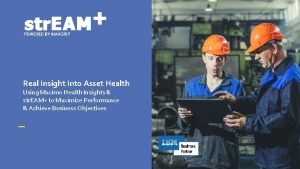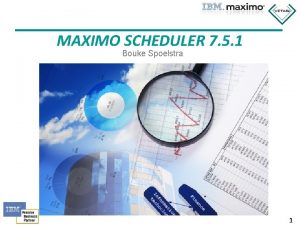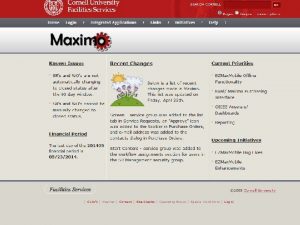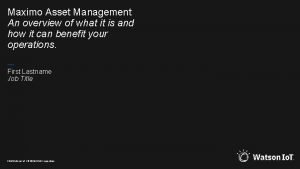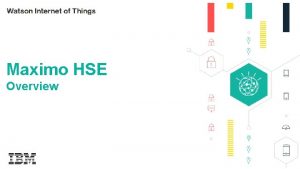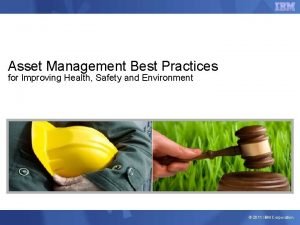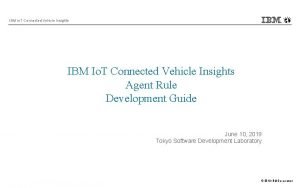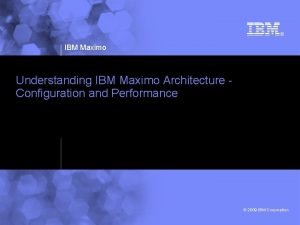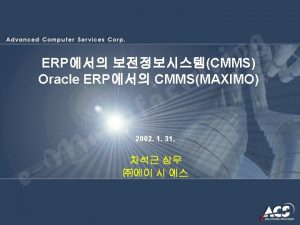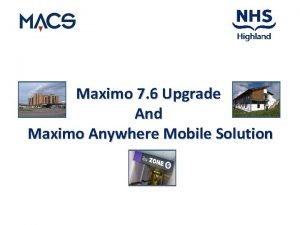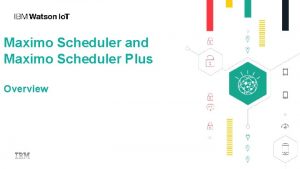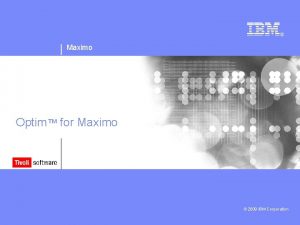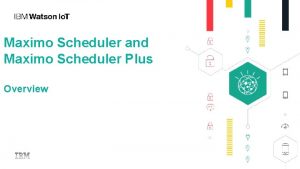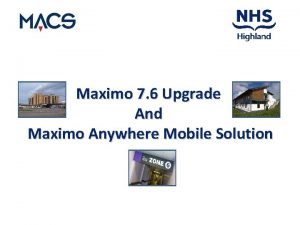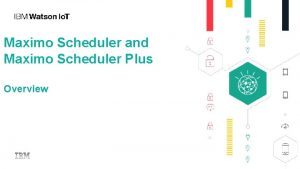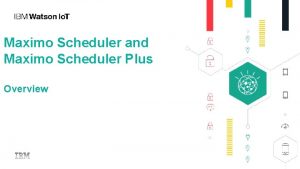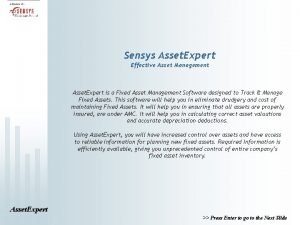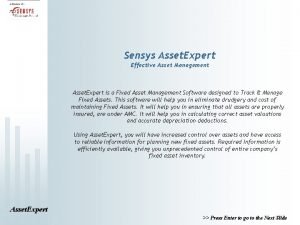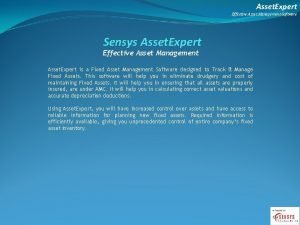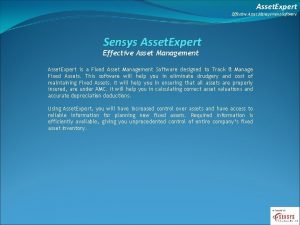Gaining New Insights into Asset Health Using Maximo























- Slides: 23

Gaining New Insights into Asset Health Using Maximo and Watson Io. T Platform Presenter: Simon Rothwell Sales Executive Email: simon. Rothwell@uk. ibm. com

Please Note • IBM’s statements regarding its plans, directions, and intent are subject to change or withdrawal without notice at IBM’s sole discretion. • Information regarding potential future products is intended to outline our general product direction and it should not be relied on in making a purchasing decision. • The information mentioned regarding potential future products is not a commitment, promise, or legal obligation to deliver any material, code or functionality. Information about potential future products may not be incorporated into any contract. • The development, release, and timing of any future features or functionality described for our products remains at our sole discretion. • Performance is based on measurements and projections using standard IBM benchmarks in a controlled environment. The actual throughput or performance that any user will experience will vary depending upon many factors, including considerations such as the amount of multiprogramming in the user’s job stream, the I/O configuration, the storage configuration, and the workload processed. Therefore, no assurance can be given that an 2 individual user will achieve results similar to those stated here.

As much as 70 percent of your investment in preventive maintenance has no effect on your uptime metrics Time based PM Schedules do little to prevent failures…. Only 11 percent of failures follow an age degradation pattern; 89 percent of failure patterns occur at random. 3

Most companies are aware of wasted work efforts and seek to eliminate it Traditional preventive maintenance embraces a time based approach • Consuming expensive resources • Potentially introducing failure by disrupting stable systems 40% of preventive maintenance costs are spent on assets with negligible affect on uptime 1 30% of preventive maintenance activities are carried out too frequently 2 45% of all maintenance efforts are ineffective 2 1 Source: T. A. Cook, Maintenance Efficiency Report 2013, August 2013. http: //uk. tacook. com/fileadmin/files/3_Studies/2013/T. A. _Cook_Maintenance_Efficiency_Report_2013_En. pdf? tracked=1 2 Source: Oniqua Enterprise Analytics, Reducing the Cost of Preventative Maintenance, http: //www. plant-maintenance. com/articles/PMCost. Reduction. pdf 4

Condition based maintenance uses Io. T data to assess asset health Reduce maintenance costs by up to 25% Eliminate up to 70% of breakdowns Reduce downtime by up to 50% The results speak for themselves Cut unplanned outages by up to 50% Reduce scheduled repairs by up to 12% Reduce capital investment by 3 -5% 5

Challenges to Gaining Meaningful Insights from Assets Knowing status of critical business assets “I need to monitor device behaviors in real-time to understand assets that aren’t working as expected. ” Optimizing maintenance schedules based on early warnings from assets “I need to detect that something is wrong and schedule maintenance before failure. ” Avoid unplanned downtime “Can I prevent problems before they occur by forecasting imminent issues and initiate appropriate responses to avoid run to failure? ” Minimize unnecessary repairs “I need insights from devices in the field to schedule repair only when needed. ” Identify economic outcomes and risks associated with your asset strategy “Should I repair, replace, or shift load on my asset to extend it’s life? ”

Basic condition triggers available via Maximo PM Module today Continuous Gauge Characteristic Counters Numeric Range Observations Odometer Thermometer Level of Service They aggregate They fluctuate Discrete values • Some sample use cases: • When a tank is low, initiate work to fill it • When pressure differential on a filter is above x, replace the filter • When output pressure drops for a pump, schedule an inspection • Readings exceeding user defined values trigger a PM Work Order

Maximo condition triggers can be enhanced with Schad Automation link to SCADA Systems • • • Software product that provides connectivity to Control Systems (SCADA, PLC, BMS) via a wide range of industry standard protocols such as OPC, Bac. Net, etc. Enables mapping of sensors to assets in Maximo Allows data from control systems to be sent to Maximo’s Condition Monitoring module Includes MQTT Integration to enable: • using IBM Message. Sight for efficient and secure remote site connectivity • providing data to the IBM Watson Io. T Platform Ability to define simple rules for notifications or for creating Maximo work orders/service requests Reduces need for physical inspections or meter readings Rapid connection of SCADA information into Maximo Data can be used for trend analysis to optimize preventive maintenance Highly scalable, capable of measuring millions of data points across multiple sites

Real time and Historical Sensor data Maximo Asset Information Asset Health Condition data is enhanced when combined with contextual information to give a more perfect picture of Asset Health • Real time sensor data from the equipment via individual sensors (add-on or embedded) • Real time sensor data or alerts from SCADA systems • Historical trends of sensor data from historian or other data repository • Inspection data that might include measurements, observations, photos gathered manually or from mobile devices • Maintenance history of the asset • Related information such as environmental (temp, humidity, etc. ), weather, usage, output

Today there are multiple sources and systems for assessing asset health SCADA Enterprise (Homegrown System) RPM (Renewal Planning Model – 3 rd party) Maximo

Maximo Asset Health Insights Planned 3 Q 2016 Business Outcomes Subscribe to warnings and notifications for response to Asset issues prior to failure. Define Asset Health using data from many sources including Maximo and Real-time Remaining useful life Maintenance and failure history Asset Condition based on real time and historical information Improved Asset Strategy Reduce Unnecessary Maintenance Downtime Avoidance Normalization of Health Score Define Scoring Methodology Asset Useful Life Maintenance History Visual Inspections Run Hours Subcomponents Filtering and Rules Applied Leverage Historical Weather as a Key Element in determining Asset Health IBM Watson Io. T Platform Minimize unnecessary maintenance based on Asset Health score. Insights to determine repair vs. replace SCADA Io. T enabled Applications Sensor Data Raw Data Weather 11

Maximo, and the Watson Io. T Platform delivering value together 1 Real Time data from low cost add-on sensors 2 Real time filtered data from automation systems • Contextualizes device data • Monitors streaming data to detect situations • Filters the data for analysis by Maximo Users • Stores data for further analysis IBM Maximo Asset Health Insights • • IBM Watson Io. T Platform • 3 Historical sensor data • Historical Weather data 4 • Enables Immediate action and/or Provides engineers with rich set of sensor and asset data to determine proper course of action Visibility into asset condition, from asset lifecycle perspective Consolidates Asset data, historical and real-time, including data from external data systems, weather data, etc. Advanced dashboard view enables proactive asset and maintenance decisions 1

Customizable Work Center for Reliability Engineers 13

Drill into Specific Contextual Data for Assets Meter Readings

Asset Health in action If the diagnostic data is available in real time for a locomotive, I can decide whether I need to hit the reset button, saving 1, 000 euro’s per train, or take it out of service to bring it to the maintenance center for repair. Understanding the vibration and temperature of a pump, along with the maintenance history will indicate whether I should inspect, perform routine maintenance or schedule the asset for replacement. The least cost option or optimal timing can then be assessed.

Why Consider Leveraging Asset Health? 1 2 3 Reduce the cost and frequency of asset failures • Perform maintenance while the asset is working to reduce disruptions to operations • Improves overall equipment reliability Minimize unscheduled downtime due to catastrophic failure • Optimizes time spent on maintenance • Reduces overtime costs by scheduling the activities • Decreases requirement for emergency spare parts Reduce maintenance workload and costs with PM optimization • Defer unneeded maintenance • Prioritize PM workload based on condition

Summary and Next Steps 1 Leveraging real-time and historical sensor information for assets has tremendous benefits. 2 Combination of sensor data with asset history provide great insights into overall asset health 3 Begin planning for how Maximo Asset Health Insights will benefit your organization


Backup 19

Further understand your assets: Predictive Analytics 20

When should I use Predictive Analytics? 1 When assets are complex with multiple sensor data feeds. 2 When historical sensor data, asset maintenance and/or failure data is available (minimum of 6 months > ). 3 When early indicators of asset failure are unknown. 4 When criticality of assets demand early warning before normal human operation can detect any degradation. 5 When cost/risk of disruption due to asset failure is high.

IBM Predictive Maintenance on Cloud Ingest data from Maximo and augment it with information from other sources • • maintenance logs inspection reports repair invoices warranty claims Maximo Records Instrumentatio n Real-time, fact-based understanding of asset performance and usage • reduced unplanned downtime • lower maintenance costs • lower parts and inventory costs Connectivity Analytics External Feeds • extended asset life • improved production yield • optimized maintenance schedule

Move to Advanced Stages of Asset Management with Io. T Asset Management Maturity Usage based Condition based Performance Business Impact Prescriptive Calendar based Asset value & Business Impact Maintenance is an expense Instrumented • Ever increasing range of sensors • Volume, velocity, variety • Event driven information Interconnected Maintenance is an investment • Agility and Mobility • Highly Connected Systems • Cross Collaboration Intelligent • From data to actionable intelligence • From reactive to proactive • Whole lifecycle system optimization
 Asset health insights
Asset health insights Ibm maximo roadmap
Ibm maximo roadmap Maximo mobile asset manager
Maximo mobile asset manager Maximo asset management scheduler
Maximo asset management scheduler Maximo test usability
Maximo test usability Maximo enterprise asset management system
Maximo enterprise asset management system Maximo scheduler demo
Maximo scheduler demo Managing marketing information to gain customer insights
Managing marketing information to gain customer insights Semi-tabular presentation
Semi-tabular presentation Using marketing information to gain customer insights
Using marketing information to gain customer insights Maximo health safety and environment manager
Maximo health safety and environment manager Maximo health safety and environment manager
Maximo health safety and environment manager Asset management companies using social media
Asset management companies using social media Data insights quotes
Data insights quotes Otava opiskelijan maailma ei toimi
Otava opiskelijan maailma ei toimi Social media consumer insights
Social media consumer insights Relie respondible lending solution
Relie respondible lending solution Demand measurement in marketing
Demand measurement in marketing Aruba ai insights
Aruba ai insights Connected vehicle insights
Connected vehicle insights Exploration insights
Exploration insights Resolution 435 s. 1997
Resolution 435 s. 1997 Cisco network insights advisor
Cisco network insights advisor Dale sanftl
Dale sanftl
